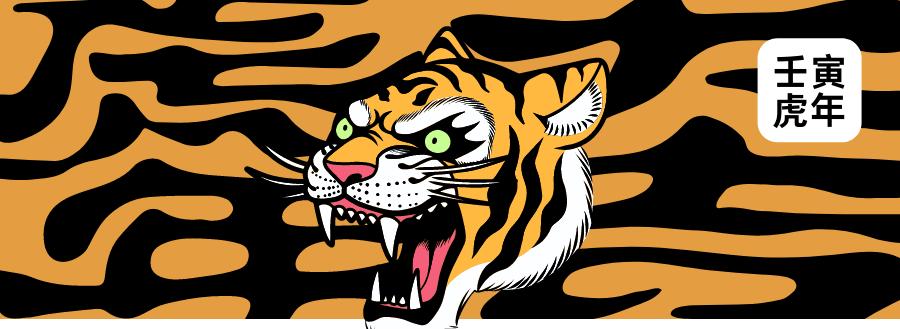
Everyone's Spring Festival is good~
Today is the sixth day of the Chinese New Year (the holiday is almost over).
So many days have passed since the Year of the Tiger,
How much do you know about tigers?
Tiger, called "vyaghra" in Sanskrit, "bagh nakh" in Hindi, "puli" in South India, "macan" in Javanese, "harimau" in Malay, "namur" in Arabic, etc. all have their own names. It is called "tiger" in English, and the names of other European countries are much the same. These names are derived from the Greek and Latin "tigris". The so-called "tigris", in Greek, originally means bow and arrow, probably because the ancients believed that the galloping tiger was as fast as a flying bow and arrow. In ancient Japan, people did not see the tiger with their own eyes, but they still believed in the theory that the tiger traveled a thousand miles, so in the drama, the famous name of "Thousand Mile Jumping Tiger Nosuke" was used to praise the agile tiger hero Kato Kiyomasa.
Kiyomasa Kato's Defeat of the Tiger
According to Pliny the Elder's Naturalist, the first time the Romans saw the tiger was during the reign of the Roman Emperor Augustus. Europeans had seldom had the opportunity to see a real tiger before, so after hearing the Greeks describe the legend that a tiger preyed on a bow and arrow as fast as a flying bow and arrow, Pliny the Elder described the tiger in the twenty-fifth chapter of Book VIII of the Naturalist: "The tiger haunted Bihar and India, walked like a fly, and gave birth to many children." Tigers run fastest when they are snatched away. For example, once a hunter quietly stole a tiger cub from a tiger's den, and then sped away with a quick whip. The male tiger is blind, while the female tiger returns to the cave and finds the abnormality. When the female tiger chased closer, the hunter dropped a tiger cub from the horse, and the female tiger immediately returned to the hole and continued to chase. So the hunter dropped another one, and the tiger snatched it back into the hole. When the tiger returned, the hunter had already escaped to the boat with the remaining tiger cubs, and the female tiger could only sigh. From the 17th century onwards, Europeans began to sail in search of new continents, giving them the opportunity to witness the majesty of tigers in nature, knowing that tigers could not travel as long distances as imagined. Thus, Thomas Brown of England corrected Pliny Sr.'s misunderstanding in "Colloquial Discernment".
Li Shizhen once said: "Tiger, like its voice." That is, the tiger's name is taken from its roar. This insight is extremely insightful. Since ancient times, animals have mostly been named after their roars. Kenjiro Hamada once verified this view with examples in Japanese in the Gakugei Shibayashi. In addition, the tiger has many aliases. In Chinese books after the Jin Dynasty and Liang Dynasty, tigers are often called "big worms". This is just like the Swedish cattle girl who honors the wolf as the "Silent One", "Gray-footed Beast", and "Golden Tooth", and the bear as "Lord", "Uncle", "Twelve Manpower" and "Golden Foot", and never calls him by his name. Farmers in Sweden, in order to ward off evil spirits, are forbidden to call rats and snakes by name two weeks before Ascension. The Kannara people also do not call the tiger by its first name, and the Bengalis honor the tiger as "uncle". According to the North Vietnamese Snow Spectrum, lumberjacks and hunters use the metaphor to refer to bears, wolves, and women's genitals, while in the Kumano region they call rabbits "witches" and wolves "mountain gods" or "guest officers.", and in the mountains they never call tengu by their names and call them "superiors."
In China, the tiger is sometimes called "Li Er". Guo Pu of the Jin Dynasty once said: "Tiger food, the value of the ear is stopped, so call Li Er." Touch it. Ying Shao of the Han Dynasty said that it was because Li Weng of Nan County turned into a tiger that he was called "Li Er". Li Shizhen of the Ming Dynasty believed that these explanations were "unsophisticated words". Li Shizhen explained: "Li Er is regarded as a tanuki, Gai Fangyin is transformed into a tanuki, and Er is also an ear. The people of the present south call the tiger a cat, that is, this is also the meaning. The Japanese refer to raccoons as "tanuki", and in China, people used to refer to foxes and wild cats collectively as foxes, and cats as "domestic foxes".
From this, it can be inferred that "tanuki" is a derogatory term for a tiger, just as the Buddhist scriptures derogatorily refer to a dragon as a "little snake". Similarly, the Japanese compare cats to tigers, and there is a passage in the "Hundred Talks of the World": "Although there is a great difference between tigers and cats in terms of size and rigidity, their appearance is extremely similar, and there has been a saying that cats are domesticated tigers in the mainland since ancient times." There are also corresponding records in the Waka of the Ancient and Modern Waka And the Tale of Genji. The Chinese novel is commonly known as the tiger as a bobcat "Journey to the West" The thirteenth time "Trap the Tiger's Den Venus To Solve the Problem, double fork ridge Bo Qin Liu monk" there is "Bo Qin Dao: 'Where the wind rings, it is a bobcat coming... I saw only a colorful tiger, and I bumped into it on the other side. Such fragments, this description shows that Bertchin bravely despises the tiger as a bobcat.
There is still a lot of knowledge about tigers, and Pu Ruijun invites everyone to open the "Zodiac Strange Tan" together to increase knowledge